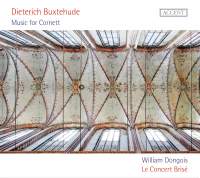Texte paru dans: / Appeared in:

Fanfare Magazine: 38:2 (11-12/2014)
Pour
s'abonner / Subscription information
Les abonnés à Fanfare Magazine ont accès aux archives du
magazine sur internet.
Subscribers to Fanfare Magazine have access to the archives of the magazine
on the net.
Accent
ACC24291

Code-barres / Barcode : 4015023242913
Recommended.
The title of this album, Sonatas with Cornett, is a misnomer—most importantly, because five of the nine pieces are for solo organ. Which isn’t to say that the organ receives the lion’s share of recorded time, since the four sonatas all run over nine minutes (with two at or over 11), while only one of the five organ works manages that.
If we pursue accuracy, we also have to acknowledge that the remaining four works are all transcriptions of Buxtehude sonatas for violin, viol da gamba, and harpsichord for cornett, trombone, and organ. There’s nothing wrong with this. Arrangements fed both the public’s need for new works to perform and hear, and a boom in the music publishing industry that lasted well into the 19th century. Nor, when one drills down, are the cut listings completely accurate, either. The Sonata in A Minor, whose origin is stated as “MS Uppsala,” leads one to expect a previously unrecorded work thanks to transmission by manuscript, when it is in fact Buxtehude’s popular Sonata in A Minor, BuxWV 272, with some (admittedly significant) differences in the variations over the ostinato bass.
So if you came to this album expecting cornett sonatas, you might be disappointed to discover that roughly 23 of its 63 minutes are for organ, and that the remainder is made up of transcriptions. There’s nothing wrong with that, but it isn’t as advertised.
The performances are considerably less problematic. Le Concert Brisé (William Dongois, cornett, Stefan Legée, trombone, Pierre-Alain Clerc, organ) is stylistically idiomatic, warm-toned, and technically exuberant. Dongois in particular displays an airy fluency in the Sonata in B♭ Major, BuxWV 255, that erases for the moment all thoughts of the piece’s original instrumentation; and Clerc never slows Buxtehude’s charming, smaller works in order to make more of them than he should. Nor does the sound exaggerate the church reverberation in either the solo organ works or the sonatas.
Personally, I could have wished for more of the transcribed sonatas, and less of the frequently recorded organ music. (ArkivMusic lists 25 versions of the Praeludium in G Minor, alone, and while some of those are doubles, it’s clearly well represented in the catalog.) That noted, this is an attractive release. Recommended.
Cliquez l'un ou l'autre
bouton pour découvrir bien d'autres critiques de CD
Click either button for many other reviews


